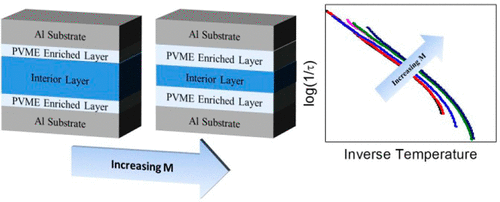当前位置:
X-MOL 学术
›
Macromolecules
›
论文详情
Our official English website, www.x-mol.net, welcomes your
feedback! (Note: you will need to create a separate account there.)
Role of Thickness Confinement on Relaxations of the Fast Component in a Miscible A/B Blend
Macromolecules ( IF 5.1 ) Pub Date : 2018-01-18 00:00:00 , DOI: 10.1021/acs.macromol.7b02152 Ravi P. Sharma , Ban Xuan Dong , Peter F. Green 1
Macromolecules ( IF 5.1 ) Pub Date : 2018-01-18 00:00:00 , DOI: 10.1021/acs.macromol.7b02152 Ravi P. Sharma , Ban Xuan Dong , Peter F. Green 1
Affiliation

|
Spatial compositional heterogeneity strongly influences the dynamics of the A and B components of bulk miscible blends. Its effects are especially apparent in mixtures, such as poly(vinyl methyl ether) (PVME)/polystyrene (PS), where there exist significant disparities between the component glass transition temperatures (Tgs) and relaxation times. The relaxation processes characterized by distinct temperature dependencies and relaxation rates manifest different local compositional environments for temperatures above and below the glass transition temperature of the miscible blend. This same behavior is shown to exist in miscible PS/PVME films as thin as 100 nm. Moreover, in thin films, the characteristic segmental relaxation times τ of the PVME component of miscible PVME/PS blends confined between aluminum (Al) substrates decrease with increasing molecular weight M of the PS component. These relaxation rates are film thickness dependent, in films up to a few hundred nanometers in thickness. This is in remarkable contrast to homopolymer films, where thickness confinement effects are apparent only on length scales on the order of nanometers. These surprisingly large length scales and M dependence are associated with the preferential interfacial enrichment—wetting layer formation—of the PVME component at the external Al interfaces, which alters the local spatial blend composition within the interior of the film. The implications are that the dynamics of miscible thin film blends are dictated in part by component Tg differences, disparities in component relaxation rates, component–substrate interactions, and chain lengths (entropy of mixing).
中文翻译:

厚度限制对可混溶A / B混合物中快速组分松弛的作用
空间组成的异质性强烈影响本体可混溶共混物的A和B组分的动力学。它的影响在混合物中尤为明显,例如,聚(乙烯基甲基醚)(PVME)/聚苯乙烯(PS),其中组分玻璃化转变温度之间存在显着差异(T gs)和放松时间。以明显的温度依赖性和弛豫速率为特征的弛豫过程对于高于和低于可混溶共混物的玻璃化转变温度的温度表现出不同的局部组成环境。事实证明,在薄至100 nm的可混溶PS / PVME膜中也存在相同的行为。此外,在薄膜中,限制在铝(Al)基质之间的可混溶PVME / PS混合物的PVME组分的特征性段弛豫时间τ随着分子量M的增加而减小PS组件。这些松弛速率取决于膜厚度,在厚度高达几百纳米的膜中。这与均聚物薄膜形成鲜明对比,均聚物薄膜的厚度限制作用仅在纳米级的长度尺度上才明显。这些出乎意料的大长度尺度和M依赖性与外部Al界面处PVME组分的优先界面富集(湿润层形成)有关,这会改变膜内部的局部空间共混物成分。其含义是,可混溶的薄膜共混物的动力学部分由组分T g决定。 差异,组分弛豫率的差异,组分与底物的相互作用以及链长(混合熵)。
更新日期:2018-01-18
中文翻译:

厚度限制对可混溶A / B混合物中快速组分松弛的作用
空间组成的异质性强烈影响本体可混溶共混物的A和B组分的动力学。它的影响在混合物中尤为明显,例如,聚(乙烯基甲基醚)(PVME)/聚苯乙烯(PS),其中组分玻璃化转变温度之间存在显着差异(T gs)和放松时间。以明显的温度依赖性和弛豫速率为特征的弛豫过程对于高于和低于可混溶共混物的玻璃化转变温度的温度表现出不同的局部组成环境。事实证明,在薄至100 nm的可混溶PS / PVME膜中也存在相同的行为。此外,在薄膜中,限制在铝(Al)基质之间的可混溶PVME / PS混合物的PVME组分的特征性段弛豫时间τ随着分子量M的增加而减小PS组件。这些松弛速率取决于膜厚度,在厚度高达几百纳米的膜中。这与均聚物薄膜形成鲜明对比,均聚物薄膜的厚度限制作用仅在纳米级的长度尺度上才明显。这些出乎意料的大长度尺度和M依赖性与外部Al界面处PVME组分的优先界面富集(湿润层形成)有关,这会改变膜内部的局部空间共混物成分。其含义是,可混溶的薄膜共混物的动力学部分由组分T g决定。 差异,组分弛豫率的差异,组分与底物的相互作用以及链长(混合熵)。











































 京公网安备 11010802027423号
京公网安备 11010802027423号